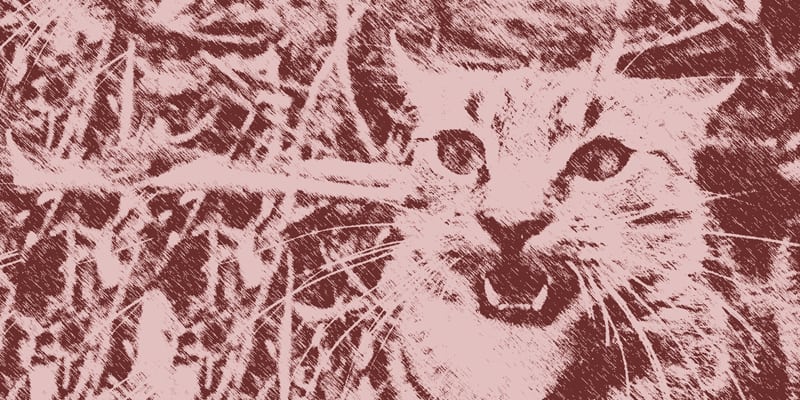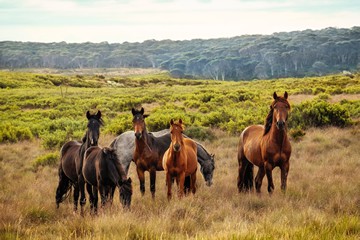“We can have healthy ecosystems, pristine waterways and abundant native wildlife in the Australian Alps, or we can have thousands of feral horses – we can’t have both.”
Indigenous river guide and Invasive Species Council Ambassador, Richard Swain
The Invasive Species Council appreciates the opportunity to make a submission to this important Senate inquiry into the impacts and management of feral horses in the Australian Alps.
In November 2008, the Australian Alps National Parks and Reserves were included on the National Heritage List. Then Federal Minister for the Environment, Heritage and the Arts, Peter Garrett declared that the decision to list the Alps’ recognised “the outstanding natural, Indigenous and historic values of this iconic landscape.”
This was a historic moment and an important environmental legacy. National Heritage listing under the Environment Protection and Biodiversity Conservation (EPBC) Act 1999 is meant to ensure that those special values will be protected forever at a federal level.
Sadly, those values are being rapidly degraded as increasing numbers of highly damaging feral horses’ trash and trample the sensitive alpine ecosystems of the Australian Alps.
Streams that were once lined by precious sphagnum moss are now scarred erosion channels. The habitat of critically endangered animals, like the northern corroboree frog and mountain pygmy possum, is being severely damaged. Rare alpine daisies and orchids that are found nowhere else in the world are directly at risk of extinction due to feral horse impacts.
As well as degrading the National Heritage values of the Australian Alps, a failure to control feral horses undermines other Commonwealth responsibilities, including:
- ensuring the survival of at least 28 threatened species and two threatened ecological communities listed under the EPBC Act,
- upholding the Commonwealth’s specific obligations under the UN Convention on Biological Diversity for the protection and management of native biodiversity and protected areas,
- protecting the headwaters of the Murray and Murrumbidgee rivers and the quality and quantity of Murray-Darling Basin water resources,
- meeting the goal of no new extinctions under their Threatened Species Action Plan.
With adequate resources, appropriate methods, and consistent control, eradicating feral horses from the Australian Alps is possible. However, State Governments, and in particular the NSW Government, have consistently failed to implement policies and programs to effectively reduce feral horse numbers.
To uphold the Commonwealth’s clear responsibility to protect the wildlife, water and ecosystems of the Australian Alps, the Invasive Species Council submits that the Commonwealth Government must act to ensure the effective and urgent removal of feral horses.
If requested, the Invasive Species Council would be pleased to provide in-person evidence to the committee.
Recommendations to protect the Australian Alps
Recommendation 1:
The NSW Government should repeal the Kosciuszko Wild Horse Heritage Act which prioritises feral horses over native wildlife in a National Park and undermines Australia’s national and international environmental obligations.
Recommendation 2:
The NSW National Parks and Wildlife Service should be empowered and resourced to carry out operations in Kosciuszko National Park consistent with a goal to eliminate feral horse damage through a significant reduction in numbers, prevention of their re-introduction and restoration of horse-damaged areas.
Recommendation 3:
Federal, state and territory Governments should not adopt policies or management plans which include goals to retain feral horses or other invasive species in National Parks or other protected areas.
Recommendation 4:
All jurisdictions should use the full suite of control tools available, ensuring they meet standard operating procedures and animal welfare requirements, to reduce the significant impacts of feral horses on the Australian Alps. This should include ground and aerial shooting by professionals.
Recommendation 5:
Feral horse control programs in the Australian Alps should be multi-year, adequately funded, coordinated across agencies and tenures, and integrated with the management of other feral animals like pigs and deer.
Recommendation 6:
The Federal Environment Minister should develop National Heritage management principles under the EPBC Act to require states and territories to effectively and urgently remove feral horses from the Australian Alps National Parks and Reserves National Heritage Place.
Recommendation 7:
Australia’s national environmental law should be reformed to ensure that ‘actions’ defined in law include a policy, plan, or program of a government where these relate to the management of National Heritage Places like the Australian Alps, as well as World Heritage Areas, or wetlands of international significance (Ramsar wetlands).
Recommendation 8:
The Australian Government should develop a national feral horse Threat Abatement Plan to drive improved action, direct funding, and coordinate management.
Recommendation 9:
The Australian Government should co-invest with state and territory governments in feral horse management in the Australian Alps, which is a priority place under the Threatened Species Action Plan.
Recommendation 10:
Australia’s national environmental law should be reformed to strengthen Australia’s threat abatement system including:
- Enabling multiple threat abatement plans to be listed for listed key threatening processes.
- Requiring the comprehensive listing of threats to matters of national environmental significance (MNES) on the advice of the Threatened Species Scientific Committee or an equivalent independent scientific body or process.
- Classifying listed threats hierarchically as:
- Key threatening processes – overarching processes such as habitat loss and invasive species.
- Threats of national environmental significance – more-specific threats within each key threatening process such as a particular invasive species
- On listing a threat of any category, requiring the Threatened Species Scientific Committee to prepare a statement about the actions (management, research) and instruments (plans, policies, regulations) needed to abate the threat (to the extent that it can be delisted).
- Streamlining the process for preparing threat abatement plans and recovery plans, and reducing the timeframes in which they must be finalised.
- Better integrating threat abatement and recovery actions, including through new proposed recovery strategies.
- The establishment of national taskforces for tackling major environmental threats
- Instituting an ‘emerging threatening process’ (ETP) category of threat to facilitate urgent or precautionary interventions.
Recommendation 11:
The Australian Government should develop strong national environmental
standards that:
- place a proactive obligation on managers of spatially defined Matters of National Environmental Significance (National Heritage places, World Heritage properties and Ramsar wetlands) for the effective protection of listed values and management of key threats; and
- require managers of spatially defined MNES to take action to prevent the exacerbation of key threatening processes, threats of national environmental significance (Rec 10), emerging threatening processes (Rec 10) and to implement relevant national threat abatement plans.
Recommendation 12:
New ‘triggers’ should be established under national environmental law for assessment and approval of:
- actions that exacerbate a key threatening process; and
- actions that negatively impact on Australia’s system of national parks and reserves.
Recommendation 13:
The Commonwealth Government should fund an officer reporting to the Australian Alps Liaison Committee to focus on interstate collaboration and best practice for feral horse control. The position should provide a public report on measures to protect MNES from feral horse impacts.
Recommendation 14:
The Australian Alps Liaison Committee should develop a multi-year strategy for feral horse management in the Australian Alps, that improves coordination and implementation of state-based strategies. It should:
- Prescribe Australian Alps-wide population targets, timeframes and required resources.
- Support the full range of best practice control methods, including aerial shooting
- Implement ongoing monitoring and adaptive management.
- Facilitate ongoing scientific and Indigenous cultural heritage research.
- Undertake public education and awareness campaigns regarding the impacts of feral horses on the environment and the need for their control.
- Encourage effective integration with other vertebrate invasive species management.
- Encourage coordinated vertebrate pest control with neighbouring land managers.
Recommendation 15:
The Alps Ministerial Council should be reinvigorated to facilitate better management of the Australian Alps, protection of its national heritage values and a focus on the issue of feral horses and other hard-hooved invasive species.
Recommendation 16:
The Federal Water Minister should investigate powers under the Water Act 2007 to ensure that feral horses are not damaging and polluting the catchments of the Murray and Murrumbidgee River.
Recommendation 17:
The Murray Darling Basin Authority should undertake an assessment of the impact of feral horses and other hard-hooved invasive species on water quality and erosion and any actions required to prevent, mitigate, or repair the damage.
Recommendation 18:
Feral horse removal should be coupled with investment in ecosystem monitoring and restoration through an integrated program of threat abatement and landscape recovery.
Recommendation 19:
The Commonwealth should work with state and territory governments to develop a comprehensive ecosystem restoration plan for the Australian Alps that:
- identifies targets and timeframes for removal of invasive species and ecosystem repair; and
- invests in ongoing ecosystem restoration and monitoring.









